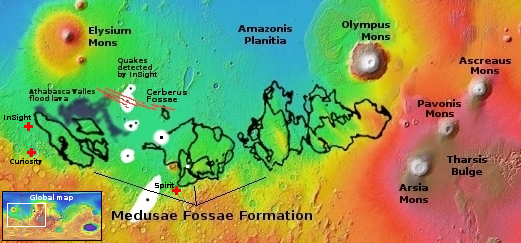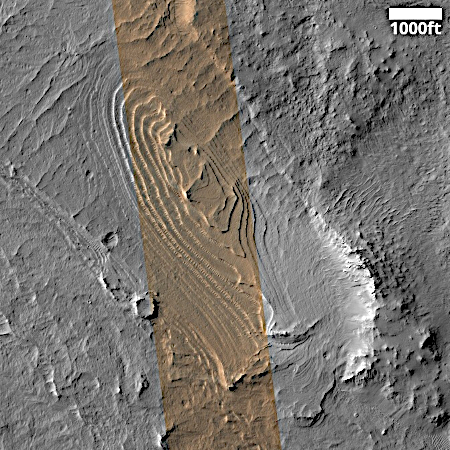Layers of Martian ash
Cool image time! The picture to the right, cropped, reduced, and sharpened to post here, was taken on August 31, 2025 by the high resolution camera on Mars Reconnaissance Orbiter (MRO).
The science team labels this as “layering”, which surely is an apt description. As the latitude is 9 degrees south, this location is within the dry tropics of Mars, where no near surface ice has yet been found. Thus, the terraced layers of this low 20-foot-high mesa are not indicative of the many glacial climate cycles found in the mid-latitudes.
Instead, we are looking at sedimentary layers of rock or dust, laid down over time and later exposed by erosion.
So what caused the layers? And what is causing them to be exposed, one by one? As always the overview map helps provide a possible explanation.

The white dot near the center of the overview map to the right marks the location, several hundred miles north of where the rover Spirit landed and inside the Medusa Fossae Formation, the largest volcanic ash deposit on Mars (about the size of India) and believed to be the source of much of the red planet’s dust.
The layers thus likely represent different volcanic eruptions over time, each laying down a new deposit of volcanic ash. Since the major volcanoes of Mars have been largely inactive now for about a billion years, there has been ample time since for the thin wind of Mars to slowly peel away this ash, revealing this terraced butte.
That’s my off-the-cuff theory, strengthened by other images in this region showing similar layering.
It is also possible however that these layers are not ash, but frozen lava, also laid down by multiple eruptions. The Medusae Fossae Formation is patchy in this region, so we might be looking at old lava, not ash deposits.
On Christmas Eve 1968 three Americans became the first humans to visit another world. What they did to celebrate was unexpected and profound, and will be remembered throughout all human history. Genesis: the Story of Apollo 8, Robert Zimmerman's classic history of humanity's first journey to another world, tells that story, and it is now available as both an ebook and an audiobook, both with a foreword by Valerie Anders and a new introduction by Robert Zimmerman.
The print edition can be purchased at Amazon or from any other book seller. If you want an autographed copy the price is $60 for the hardback and $45 for the paperback, plus $8 shipping for each. Go here for purchasing details. The ebook is available everywhere for $5.99 (before discount) at amazon, or direct from my ebook publisher, ebookit. If you buy it from ebookit you don't support the big tech companies and the author gets a bigger cut much sooner.
The audiobook is also available at all these vendors, and is also free with a 30-day trial membership to Audible.
"Not simply about one mission, [Genesis] is also the history of America's quest for the moon... Zimmerman has done a masterful job of tying disparate events together into a solid account of one of America's greatest human triumphs."--San Antonio Express-News
Cool image time! The picture to the right, cropped, reduced, and sharpened to post here, was taken on August 31, 2025 by the high resolution camera on Mars Reconnaissance Orbiter (MRO).
The science team labels this as “layering”, which surely is an apt description. As the latitude is 9 degrees south, this location is within the dry tropics of Mars, where no near surface ice has yet been found. Thus, the terraced layers of this low 20-foot-high mesa are not indicative of the many glacial climate cycles found in the mid-latitudes.
Instead, we are looking at sedimentary layers of rock or dust, laid down over time and later exposed by erosion.
So what caused the layers? And what is causing them to be exposed, one by one? As always the overview map helps provide a possible explanation.

The white dot near the center of the overview map to the right marks the location, several hundred miles north of where the rover Spirit landed and inside the Medusa Fossae Formation, the largest volcanic ash deposit on Mars (about the size of India) and believed to be the source of much of the red planet’s dust.
The layers thus likely represent different volcanic eruptions over time, each laying down a new deposit of volcanic ash. Since the major volcanoes of Mars have been largely inactive now for about a billion years, there has been ample time since for the thin wind of Mars to slowly peel away this ash, revealing this terraced butte.
That’s my off-the-cuff theory, strengthened by other images in this region showing similar layering.
It is also possible however that these layers are not ash, but frozen lava, also laid down by multiple eruptions. The Medusae Fossae Formation is patchy in this region, so we might be looking at old lava, not ash deposits.
On Christmas Eve 1968 three Americans became the first humans to visit another world. What they did to celebrate was unexpected and profound, and will be remembered throughout all human history. Genesis: the Story of Apollo 8, Robert Zimmerman's classic history of humanity's first journey to another world, tells that story, and it is now available as both an ebook and an audiobook, both with a foreword by Valerie Anders and a new introduction by Robert Zimmerman.
The print edition can be purchased at Amazon or from any other book seller. If you want an autographed copy the price is $60 for the hardback and $45 for the paperback, plus $8 shipping for each. Go here for purchasing details. The ebook is available everywhere for $5.99 (before discount) at amazon, or direct from my ebook publisher, ebookit. If you buy it from ebookit you don't support the big tech companies and the author gets a bigger cut much sooner.
The audiobook is also available at all these vendors, and is also free with a 30-day trial membership to Audible.
"Not simply about one mission, [Genesis] is also the history of America's quest for the moon... Zimmerman has done a masterful job of tying disparate events together into a solid account of one of America's greatest human triumphs."--San Antonio Express-News



Layer lines. Clearly Mars was 3d printed.
Looking over the original picture, scouting around for anything that stands out on an alien planet, I found five impact craters with splat around them… Two small ones in the upper right on both sides of the black box, two more in lower center and one large one at lower left.
Splat is common where there is near surface water, I wonder what it means for this region? That the pumas talc ash can be liquefied?